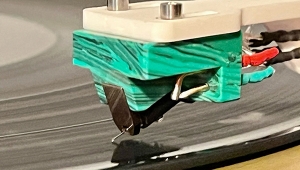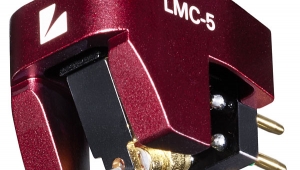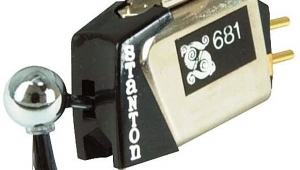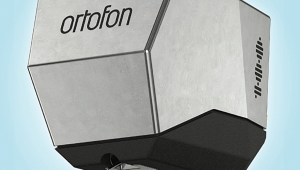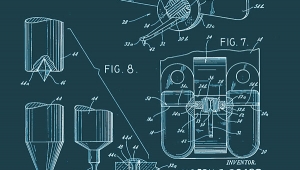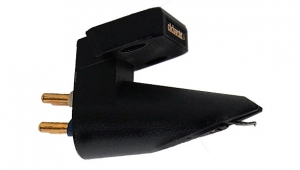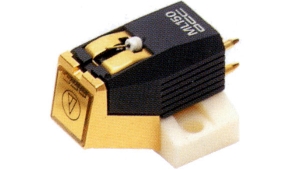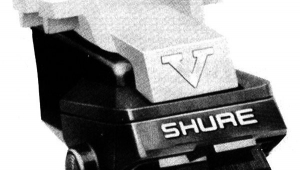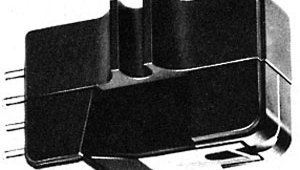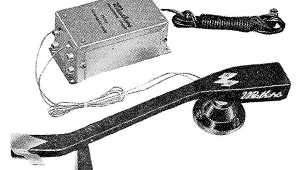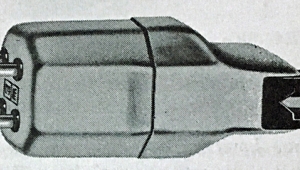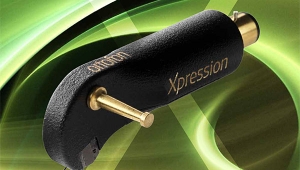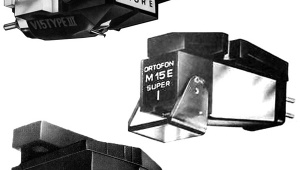| Columns Retired Columns & Blogs |
van den Hul Grasshopper IV phono cartridge Page 2
There's a certain synergy you're looking for when setting up a cartridge. After initial adjustment, place an LP on the spinning platter, lower the cartridge slowly into the groove, squint madly, and try to see how the diamond sets-in to the groove. A light magnifying tube can help here. You want the diamond fairly vertical and "straight in" under its VTF loading. Generally with the van den Huls, the stylus should emerge from the center of the hole in the pole piece and appear from a side view as if the stylus emerges more or less "straight" out of the generator—or a bit more deflected than that.
You want to optimize the relationship between VTA and VTF, assuming you previously dialed in azimuth, which may change during all these fiddlings. You don't need the sadly-out-of-production Audio-Technica device—just wire up a home-brew box that inverts polarity in one channel, play a mono record, set the preamp to dual-mono, and adjust for the greatest null (least sound). Or call Bob Graham at Graham Engineering (footnote 1) for one of his ready-made units. Alternately, you might spend a couple of hundred dollars on a used 'scope, as I did—differential the two inputs (X minus Y) and go for the flattest output trace.
The RG-8 went from rolled-off to shrill in just several small turns of adjustment, as did the 'Hopper III before it—that's the nature of the vdH line-contact stylus. Believe me, given the results obtainable when it's right, it's unquestionably worth the time and effort to dial it in. Adding small dabs of Mortite locks in a good tonal balance, tight focus, and a sense of performers having enough body and palpability. You've got to get the VTF right or all is lost. It's a pain in the pancreas, but...that's analog. Ask me if it's worth it!
With the Grasshopper IV, I settled on 1.5gm of VTF with a slight downward tilt at the back. Of course, each cartridge is different, so don't be intimidated, just use your ears. Given that, the new IV showed far less sensitivity to setup than any 'Hopper I've used to date. Really, it was a snap to dial in.
I listened to Massive Attack's bass-transient–rich and ambient Protection LP (Wild Bunch WBRLP2) while adjusting all these parameters with the Grasshopper IV, and then tweaked the arm bearing's air pressure. Varying the airflow further tightened up the bass and improved slightly the sense of spaciousness and airiness. Cut three, "Three," on Protection was thrice cool, three-wise. In any case, note-taking took place under these optimized conditions. Additionally, before critical listening sessions, I blasted the system with the Gryphon Exorcist system demagnetizer, and always treated the cartridge to Last Stylus Cleaner and Treatment between sides. Digiphobes, worry not—all digital components were turned off and unplugged from the wall sockets, interconnects removed.
Prelude to a kiss
At the time of writing, the Grasshopper IV had been in residence for some time chez Test Labs Scull. Break-in had been a long, slow, and disappointing process. A.J. encourages all 'Hopper owners to take advantage of the factory readjustment available after the first 200 hours or so. This service is free of cost save shipping, and is available to all vdH owners, not just reviewers. Accordingly, Kathleen helped me rack up the hours on the IV, and together we managed something on the order of +150 hours total. Knowing A.J. would be at WCES, I arranged with him that I'd bring it along and let him return to Holland with it for examination and adjustment.
I have to admit, things weren't looking too good at that point. The Grasshopper IV just hadn't opened up on top and was far from transparent, although it still showed good midrange textures, tonality, speed, and decent bass. It was Cinemascope wide, if nothing else. Back from Holland and mounted in a thin Forsell arm/thin Teflon spacer, Kathleen and I again piled on the hours. We were determined to give the slow-to-break-in Grasshopper IV every chance to bloom.
The hours passed—I heard harp music coming from sources indeterminate, and the pages of my calendar kept falling to the floor. I switched back to the Symphonic Line RG-8 Gold for a good deal of the Forsell The Statement review, and returned to the IV hoping the gloaming, closed-in presentation would improve (before I retired). I happened to have the Expressive Technologies SU-1 MC step-up transformer hooked up at that moment, wired with all-XLO Signature Phono Cable. [kablam] [kerpow] I suddenly felt like I'd landed in the middle of a Roy Lichtenstein painting. "But Brad, darling....!" Dynamics were explosive, bass tight and formidable, the highs extended and open (at last!), and the soundstage huge in every dimension. The Grasshopper IV seemed to have benefited from its little rest!
After a few entertaining sides, I went back to the cartridge straight into the CAT SL-1 with AudioQuest Diamond. It was obviously fully broken-in and ready for critical evaluation. It was bizarre the way it had sounded closed-in, then suddenly opened like a flower. (How do you say badaboom in Dutch?) Although use of the Expressive SU-1 silenced any RF nasties and created a sound of incredible dynamic contrasts, the transformer's inherent 85 ohm loading characteristic was just a tad too tamped-down for the 'Hopper IV.
The sound of one flower clapping
The first thing you might notice about the IV if you've run a previous Grasshopper or one of its derivatives will depend a bit on your expectations. If you imagine the Grasshopper IV is just a mo'-better Grasshopper III, think again. Its essential sound is quite different from any 'Hopper before, no doubt due to the redesigned internals and the less resonant signature of the polycarbonate body.
Where the 'Hopper III was all flash speed and zippings hither and thither, the IV was balanced more toward the relaxed, rich, and musical, while retaining most of the strengths of the 'Hoppers before it. Misadjusting the III was a piece of cake, and in such fettle it was a cinch to harden up and bite if the VTA, VTF, or azimuth were off by a nanohair. Sweet it wasn't.
The IV, however, was a little sweetie—I often wanted to pinch its little cheek! It was much more a set-it-and-forget-it affair than was the ever-touchy 'Hopper III. The Symphonic Line carried on this tradition, of course. If it wasn't set up just so, its sound was good but unremarkable. You're not paying $5000 for merely good, are you?
I was taken right away with the extremely wide soundstage the Grasshopper IV threw. Natural, you understand? But very wide—and envelopingly deep. From the intimate to the large-scale, the Grasshopper IV spread out an enormous, lustrous, layered, and beautifully populated soundstage. For example, record-maven Jerry Gladstein came through recently with a Six-Eye of one of my favorite albums, Duke Ellington's Jazz Party in Stereo (CS 8127). The difference between the Columbia Special Products blue-label re-release I'd been listening to and the Six-Eye was enormous. Listening to "Tymperterbably Blue" and "Hello Little Girl" was thrilling and totally amazing, highlighting quite nicely the overall gestalt of the Grasshopper IV.
Closing my eyes, I felt as if my listening chair had been moved from the mid-hall presentation of the Special Products pressing to right up front of the stage itself. The palpability factor was magnificent—I felt as though I could reach out and touch Dizzy Gillespie as he accompanied Jimmy Rushing on "Hello Little Girl." Each of the performers was beautifully defined upon the extremely airy and absolutely grainless soundstage. The nine timpani stretched across the back sounded visceral and powerful. And, most tellingly, the sound was redolent with sweetness and richness—the very Achilles' heel of the old Grasshopper III. While not as rich as the Transfiguration AF-1 auditioned during the Survey, it was nevertheless full enough for our tastes, while retaining the speed, openness, large acoustic, and dynamics we've come to expect from the top offerings from vdH.
My 1981 Japanese Verve Ben Webster Encounters Oscar Peterson (Polydor UMV 2532) also sounded totally charming and intimate, the warmth, sweetness, and loveliness of the upper range of Coleman's tenor sax on "It Never Entered My Mind" inviting me to fall into the expressive nuance of the music. It was wondrous, charm oozing from every modulation in the groove. I heard a richness, a certain plushness to the midrange textures extending up into the treble range, that was ever so attractive. Believe me, the Grasshopper III before it never sounded so rich and harmonic, even on its best day.
Vocals were gorgeously served by the Grasshopper IV. Listening to Lou Rawls singing "Tobacco Road" and "St. James Infirmary" on Lou Rawls Live (Capitol ST 2459) brought me close to the experience of actually being there. His voice was focused, emotive, and captivating within a deep, open, and airy soundstage.
- Log in or register to post comments
